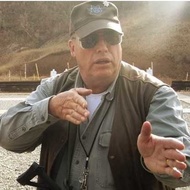2 Apr 2020
“But there isn’t enough time, Maggie.
You can have enough of everything else.
You can enough food, enough land, even enough money,
But you never can have enough time, because it’s the only thing you can’t save!
David M “Carbine” Williams (played by Jimmy Stewart) in the 1952 feature film, “Carbine Williams”
M1 Carbine:
John C Garand’s Rifle was originally designed as a long-stroke, gas-piston, self-loading ten-shooter, in 276 Pederson Caliber. As such it was short, fairly light, slim, and very handy.
Had it been adopted in that form, the M1 Carbine may have never existed.
Indeed, the M14 rifle, and the 7.62×51 (308) cartridge, may never have existed either!
But, Doug MacArthur, at the time Chairman of the Joint Chiefs, would not entertain any consideration of this new, “intermediate” cartridge! He liked Garand’s self-loading rifle, but he insisted that it be redesigned (upscaled) to shoot the existing 30-06 round (7.62×63) that had been in the US inventory since the first decade of the Century.
The resulting “M1 Garand Rifle” that was officially adopted (1936), went immediately into mass-production, and that served this nation so well all the way through WWII and the Korean War, not officially retiring until 1958, was magnificent indeed!
But, it was heavy, long, and anything but “handy!”
The Garand Rifle was too big and ponderous to be suitable for routine carrying and use by truck-drivers, tank crewmen, and “rear-area defense” by assorted clerks, cooks, et al. For that reason, these people were usually issued pistols.
The M1 Carbine project, started in 1938, was at least “officially” intended to produce a “second-tier” rifle to replace, not the M1 Rifle, but the 1911 pistol!
Available data at the time indicated to war planners that, during its tenure, the 1911 pistol was responsible for almost no enemy casualties, but was involved in innumerable UDs, many resulting in self-inflicted wounds and unintended injury to others!
It was obvious that we were using this pistol to injure ourselves far more often than to injure the enemy!
It was thought that a short, light rifle might fill the role of the pistol, but with fewer UDs!
If anyone in the System at the time had a clue about how to carry and use the 1911 pistol correctly, it may have actually been used to neutralize a few enemy combatants and surely would have been involved in far fewer UDs!
Unfortunately, vital knowledge about how to correctly carry and use this pistol was at the time confined to a few experienced LEOs (who actually carried a copy daily). By contrast, “trainers” in the active military were target competitors who didn’t even carry a pistol, any pistol!
So, this body of knowledge of modern defensive pistolcraft we today take for granted, didn’t even exist back then, or didn’t exist in any organized form, surely not where it was desperately needed. So, training was inadequate and inexpert (much as it still is today), and when these poorly-trained troops actually handled the 1911 pistol during “hot deployment,” UDs were a common result.
M1 Carbine trials were held in 1941, called the “Light Rifle Project.” The cartridge to be used, 30 Carbine, was dictated by the Army. It was an adaptation of the Winchester 32SL (self-loading) Cartridge, which had been around since 1905.
However, magazine design was not dictated, and candidate rifles submitted for testing all had their own, proprietary magazines
Winchester’s candidate was the winner, and it went into production immediately (1941).
Winchester’s Carbine employed a short-stroke gas-piston system, called the “gas-tappet,” designed by David M “Carbine” Williams while he was in prison on a murder charge! In fact, colorful Williams can be said to be the inventor of the short-stroke gas-piston system, so widely used today.
Winchester ultimately manufactured most of the M1 Carbines sold to the government, but
significant numbers were also manufactured by General Motors (Inland), Irwin‑Pedersen (Saginaw Steering Gear), Underwood Typewriter (Elliot-Fisher), National Postal Meter, Quality Hardware, IBM, Standard Products (Automotive), and Rock-Ola (jukebox manufacturer)
Over six million M1 Carbines were manufactured between 1941 and 1945.
Additional M1 Carbines were actually manufactured by the Japanese after WWII and issued to their police!
Commercial versions continue to be manufactured today by Kahr, Inland, et al.
By contrast, five and a half million Garands were simultaneously manufactured.
Between 1911 and 1945, between two and a half and three million 1911 pistols were produced (by at least a dozen different manufacturers) for the government.
Many more produced commercially, and continue to be to this day!
M1 Carbines remained in active service until 1973, but still enjoy an ardent civilian following, and can currently be found on-duty in many parts of the world!
Like AR magazines of a subsequent era, M1 Carbine magazines were not built to last. WWII and Korean War soldiers typically used an M1 carbine magazine several times and then discarded it, replacing it with a new one.
Light, short rifles are easy to carry and maneuver, but downsides include rapid overheating and parts breakage, even with mild calibers like the 30 Carbine.
When you want a rifle that doesn’t overheat quickly and doesn’t break parts, even when it gets hot, it will necessarily be robust (inside and out) and heavy, especially the barrel.
Full-auto fire will always lead to overheating and parts breakage, particularly (as noted) with “light” rifles.
Thus, when your “light” rifle has full-auto capability, as some M1 Carbines did, it accordingly must be used judiciously and sparingly!
“Carbine Williams,” a feature film about William’s colorful life, released in 1952, cast James Stuart in the starring role. Also featured was a young James Arness, later to portray Marshall Matt Dillon in the “Gunsmoke” TV series, 1955-1975
/John



